What do wildebeest, zebras, gazelles and the lockdown have in common? Text and Pictures by Urvi Piramal

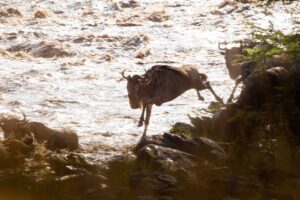
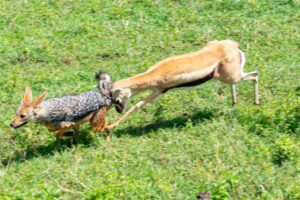
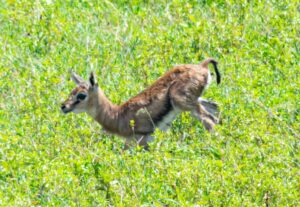
Wildebeest, zebras and gazelles wander in a loop through the plains of the Serengeti and the Masai Mara, following the seasonal rains in search of green pastures even though that involves passing through dangerous territory.
Like them and unlike them, in times of this lockdown, when the body cannot move out, my mind wanders.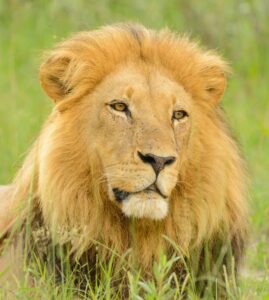
I find mine going, more often than not, to Africa: not to the majestic lion,(photo 1) nor the elusive leopard; not even to the fierce and sometimes fearsome elephants, rhinos and wild buffaloes(photo 4) but to one of the less famous and perhaps even less inspiring animals – the delicate and dainty fawn-coloured gazelle, and the wildebeest. On one of my numerous trips to Tanzania in March, I was witness to one of nature’s most beautiful spectacles: the birth of a wild animal, a little gazelle in the Serengeti. This is where the wildebeest, zebras and gazelles give birth as they wander in search of green grass.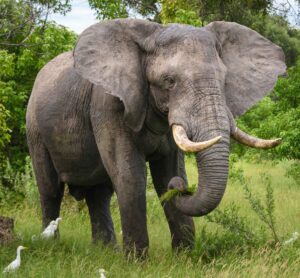
Unlike antelopes, which prefer to give birth in private, gazelles are comfortable bringing their babies into this world in front of their entire herd. I watched in wonder as the mama rolled over in the grass and a gray, gassy, balloon-like shadow substance slithered out of her. She didn’t seem particularly uncomfortable though she grunted a little.
It took a little while for this slimy mass to completely emerge from her, and within seconds, a darker-hued baby was distinguishable from the opaque substance. The baby, very unsteady on his feet,(photo 5) lolled around with the umbilical cord still dangling loosely from him. Just at that moment, from the corner of my eye, I noticed two jackals: no doubt hungry, no doubt ready, no doubt eager to pounce at what was for them an undoubtedly required meal.
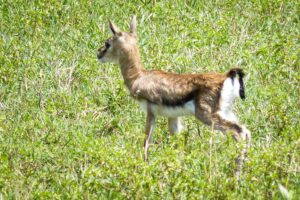 But the mother had seen them before I did and she stood up from where she had been lying in the grass and urgently nuzzled her baby – prompting him, pleading with him, firing him – to stay down. Down! It was a matter of life or death. The baby understood and stayed low, hiding in the long blades of grass. Once assured that her baby had understood the urgency, the mama butted his body reassuringly before turning with all her wrath on the two jackals.
But the mother had seen them before I did and she stood up from where she had been lying in the grass and urgently nuzzled her baby – prompting him, pleading with him, firing him – to stay down. Down! It was a matter of life or death. The baby understood and stayed low, hiding in the long blades of grass. Once assured that her baby had understood the urgency, the mama butted his body reassuringly before turning with all her wrath on the two jackals.
They say hell hath no fury like a woman scorned but I beg to differ.
 Hell hath no fury like a mama gazelle, one of the gentlest of animals, who knows her baby could be lunch to two hungry jackals: with a fury completely unexpected from her until now docile demeanour, she turned wildly upon the jackals – sending them helter-skelter. She actually chased them round our jeep a few times before packing them off – her baby left unharmed.
Hell hath no fury like a mama gazelle, one of the gentlest of animals, who knows her baby could be lunch to two hungry jackals: with a fury completely unexpected from her until now docile demeanour, she turned wildly upon the jackals – sending them helter-skelter. She actually chased them round our jeep a few times before packing them off – her baby left unharmed.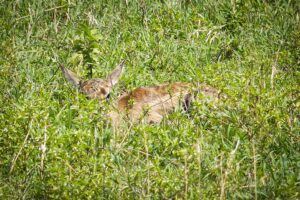
During yet another trip – this time to the Masai Mara in August, I was witness to the great annual migration. A multitude of more than two million animals strong – wildebeest, zebras and gazelles (photo 14) – move as one across the northern Serengeti plains to cross the Mara River in search (literally) for greener pastures. Wildebeest, the large, brown, scraggy and rather ugly animals that live in herds, eat grass, and belong to the cattle family, comprised the bulk of this army.
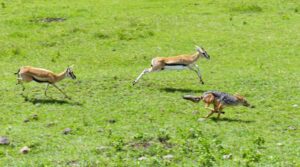
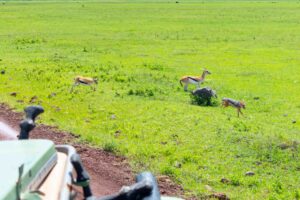
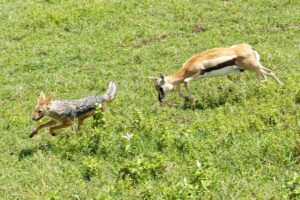
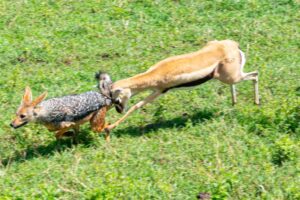
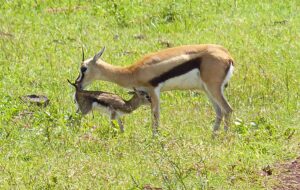
Keenly, we watched from the jeep, as the wildebeest thronged eagerly on the banks of that great river. (photo 15) The urgency was unmistakable – on the other side of the river lay fresh green grass, a better life, the promised future.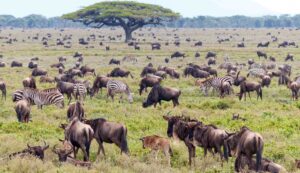
And yet, not one wildebeest took a step into that gushing river.
I didn’t blame them – the water was teeming with crocodiles – smooth and cunning under the waves, waiting with their nefarious crooked teeth to kill, to slaughter, to eat any hapless animals who lost their footing, were too young, showed any weakness. Such is life.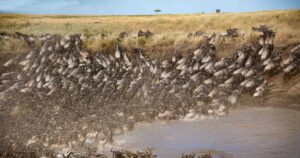
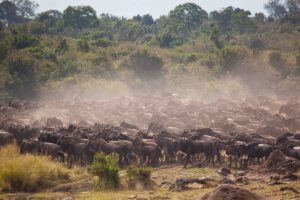
Finally, as the urgency grew and the wildebeest could handle it no longer, the leader stepped  forth. I have never thought of the wildebeest as a beautiful animal until that time. Tall, dark and handsome he stood, aware of the dangers that lay below him but mindful of his duty to take his herd to a brighter future.
forth. I have never thought of the wildebeest as a beautiful animal until that time. Tall, dark and handsome he stood, aware of the dangers that lay below him but mindful of his duty to take his herd to a brighter future.
Even the young were silent as he carefully trod into the river.(photo 16) With measured steps, he slowly edged into the water, going deeper and further each second. I watched with bated breath as he made his way mid-way and then further, stronger, until he reached the other end.
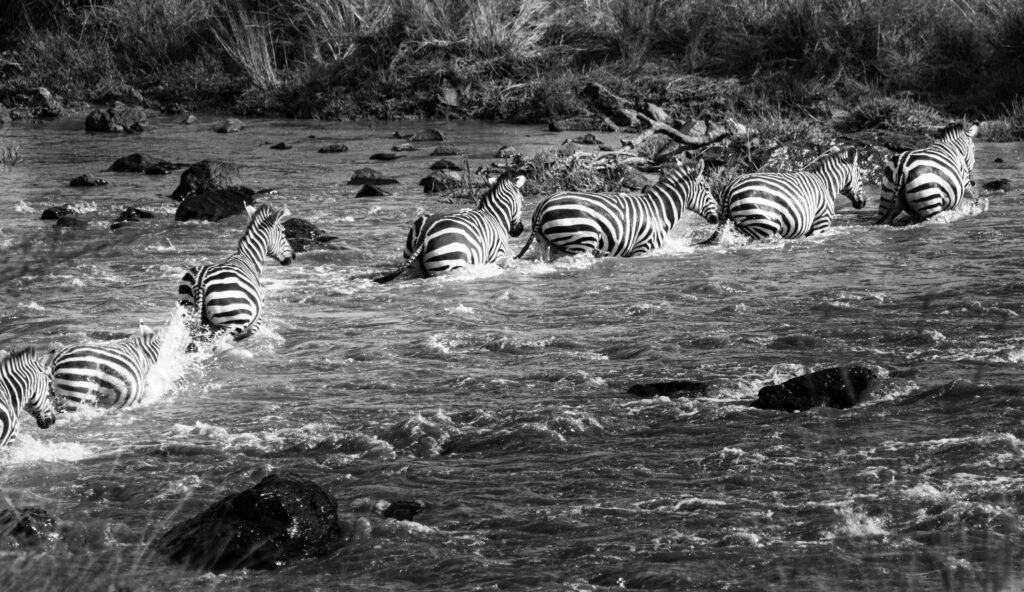

And that was the signal the herd was waiting for. Upon the success of their leader, they gained strength and like a team, like a huge black army , they began their course across the mighty river. Many failed, many lost lives.(photo 18) But their strength and conviction has stayed with me these many years.
The crossing of the river symbolises to me where we are now in our lives: in the face of the might of the fearful Covid-19, we are cowering on one side of the bank. At 60+ we have had to adapt to a complete and utter lockdown, many of us away from our families and loved ones. We have had to adapt to a life of Zoom calls and Netflix. May we ease into this new life with grace, as easily as the baby gazelle understood what she needs to do in order to survive. And may we, during this difficult time, have the strength of a sturdy wildebeest, to be able to take each day a step at a time, always going forward, with hope and courage, to a better future.




WILD LIFE VERY NICE
Urvi. Loved reading your article.
Comments are closed.